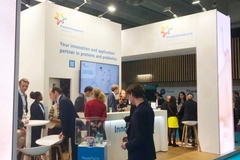Unlocking the future of food: Translating complex composition data for better nutrition

Since its inception, the Periodic Table of Food Initiative (PTFI) has been developing tools and gathering data on food composition to enhance nutrition. The initiative’s crucial next step will be to make data available for all food system stakeholders to uncover hidden nutritional insights and drive innovations for human and planetary health.
In the last installment of our series on the PTFI, Nutrition Insight delves into the complexities of translating food composition data into actionable insights. We meet with Selena Ahmed, PTFI’s global director, and Mariana Barboza, research program manager for the Innovation Institute for Food and Health at the University of California (UC), Davis, US.
The initiative collects rich metadata to characterize foods, which is represented in the Periodic Table of Food database. Currently, this is set up for research, but Ahmed says the initiative aims to expand its applications.

“We want every stakeholder in the food system to be able to use the data in meaningful ways. In this phase, we’re considering how we translate this very complex data, which most people, even us, have trouble interpreting in some cases because it’s so novel.”
“Translation needs to happen,” stresses Ahmed. “We need to synthesize and simplify, and we have not yet approached this challenge. It’s a tricky question because we’re just beginning to make sense of this and leaning into the expertise of our Centers of Excellence.”
“We’re not just measuring food; we’re discovering what’s in food. In so many ways, we don’t know the health attributes of many of these biomolecules,” she adds. “In some cases, there’s lots of knowns in food, but most of what we see is unknown. It is dark matter.”
Ahmed highlights that PTFI aims to take data obtained through multi-omics on food composition to function — determining how these compounds impact health.
Barboza says that UC Davis is identifying the complete set of proteins of 500 foods in the PTFI database.“There’s so much discovery that needs to happen,” she says.
Food discovery
Barboza adds that PTFI has developed a catalog of 1,600 foods globally, out of 30,000 edible species, to understand their composition. “From those, we have already acquired data for 500 foods into all the omics.”
Earlier this week, she explained that these combine data from different biological molecules of one specific type, such as proteomics to study proteins or metabolomics to analyze small molecules.
She says that UC Davis is identifying these foods’ proteome — the complete set of proteins.
“All the proteins of these 500 foods are in our hands. As you can imagine, we have more than half a million proteins corresponding to those foods. How do we start understanding what is in the food? We are starting to compare how those proteins are similar and different. We have vegetables, fruits, seeds, seafood, and meat — a wide diversity of foods that have been analyzed.”
“The diversity of protein is even wider,” says Barboza. “We want to understand them. I love meat, but I have a lot of friends that don’t. How can we all receive the nutrients needed to be healthy?”
She details that UC Davis is using AI and bioinformatics to understand the similarity of sources of protein to develop new foods or food replacements. “We have cartoons showing that you can replace steak with a vegetable because they’re highly similar protein-wise.”
 Ahmed sees great potential for AI to help synthesize data, which is key to translate it into actionable insights.Barboza says that AI helps to conduct these types of analyses. “The number of discoveries we make daily is phenomenal, and the idea is to bring this information to people so they can better select what foods they can eat while maintaining the nutritional density and profile they need.”
Ahmed sees great potential for AI to help synthesize data, which is key to translate it into actionable insights.Barboza says that AI helps to conduct these types of analyses. “The number of discoveries we make daily is phenomenal, and the idea is to bring this information to people so they can better select what foods they can eat while maintaining the nutritional density and profile they need.”
Translating a wealth of data
PTFI has been focusing on developing standardized tools in the last three years.
“That may seem like it took a long time, but it’s quite rapid based on what our collaborators who do standardization say,” comments Ahmed. “Now, we’re starting to apply the tools to generate data to have those research questions and have them at scale.”
She says that interpreting the complex data compiled by PTFI Centers of Excellence and other partners is one of the initiative’s key challenges. For example, the initiative is often requested to calculate nutrient density scores, which typically have nine or 16 components.
“When we have a database of 420,000 unique protein compounds and 30,000 small biomolecules, lipid components, and fiber components, how do we calculate a score with all that information?”
She underscores that “we don’t want data for the sake of data.” To ensure translation of this data, PTFI collaborates with its Centers of Excellence to make data available and drive translation. At the same time, national labs develop guidelines, dietary recommendations, and policies for their countries.
 PTFI has several chef ambassadors who are designing more nutritious and delicious recipes with the food composition data.“UC Davis has a beautiful, strong network of translational partners, many of which are food enterprises. UC Davis also has a strong foundation in agricultural extension to bring this data back into how food is grown.”
PTFI has several chef ambassadors who are designing more nutritious and delicious recipes with the food composition data.“UC Davis has a beautiful, strong network of translational partners, many of which are food enterprises. UC Davis also has a strong foundation in agricultural extension to bring this data back into how food is grown.”
Calculating nutrient density
PTFI is setting up a committee with UC Davis experts to calculate a nutrient density indicator based on thousands of nutrients, considering what should be included and how to measure these nutrients.
Ahmed says the committee considers several questions: “You can select a dietary threshold, but how do you begin to weigh things if we don’t know the dietary or health threshold, and for who?”
Other translation goals include developing more nutrient-dense crops resilient to climate change based on the holistic food composition profiles developed, reducing waste streams, or dietary recommendations.
Ahmed adds that combinations of this generated data may also support Food is Medicine programs.
“This is not isolated, siloed work — when we are developing Food as Medicine recommendations, we’re also integrating our knowledge from the agricultural system. For example, do we source from regenerative farms? How is that upregulating specific bioactive compounds that can help with heart disease or support brain health?”
AI and human capital
In addition to collaborating with its partners and experts, Ahmed sees significant potential for AI to synthesize the food data that has been generated. “AI, in addition to this powerhouse of partners that we’re continuing to build, can help bring it all together and stitch it all together.”
“AI hallucinates when we don’t have robust data. But we do have robust, standardized data, using that common language that was generated using that common ruler, using that telescope that zooms right into what is in food.”
She adds that the PTFI has several chefs as ambassadors who are designing more nutritious and delicious recipes with the food composition data.
“They are using the data to substitute more place-based ingredients,” she says. “We’re not just sourcing berries from Brazil, but considering what has a similar profile as this unique berry from Brazil, but grows over here that we can harvest locally.”












